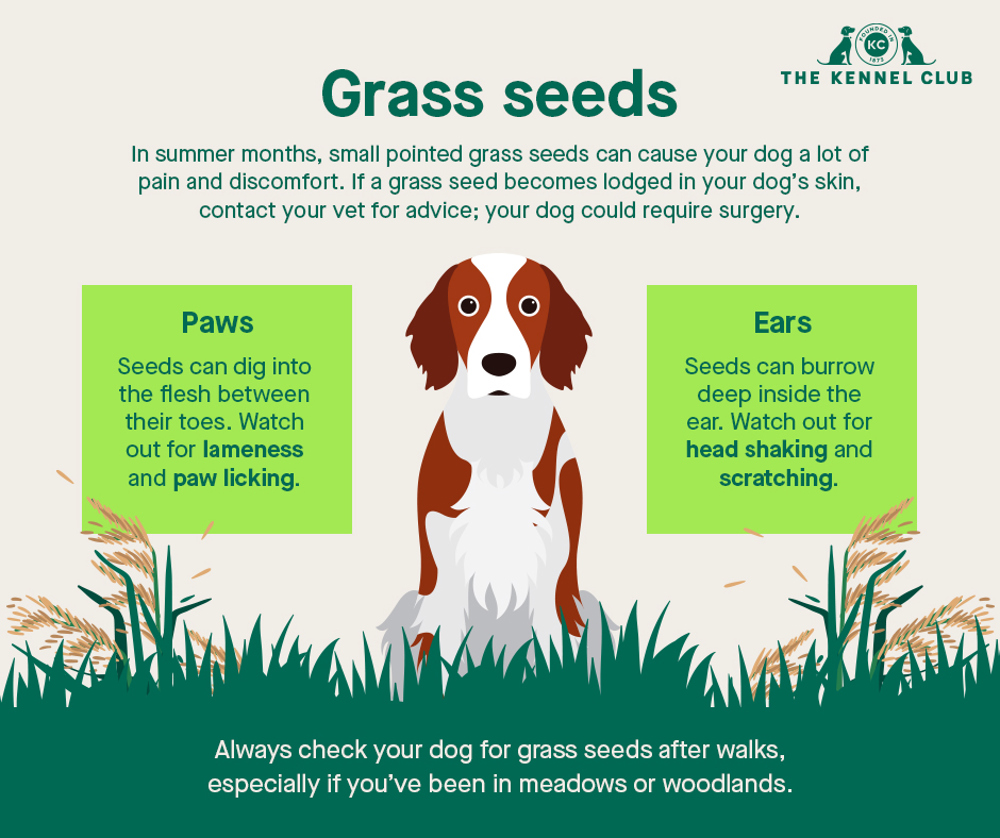
Why are grass seeds a problem for dogs?
Grass seed injuries are a common problem for dogs during summer months. When examined closely, some grass seeds resemble tiny arrowheads which attach themselves easily to an animal's fur and burrow into the skin. Breeds with hairy ears and hairy feet are more at risk if walked in meadows or woodlands where these grasses commonly grow in abundance.
Which body parts are affected by grass seeds?
The two most common areas of a dog affected by grass seeds are the foot and the ear, although other places on your dog's body can be at risk too.
Grass seeds on the feet
Grass seeds commonly get in between the toes of the dog's foot, referred to as the interdigital space. Once attached to the surrounding soft feathery fur, the grass seed then makes its way towards the foot itself, easily penetrating the thin skin before starting to burrow deep into - and through - highly sensitive tissues of the foot resulting in extreme pain, discomfort, infection and sudden onset (acute) lameness.
Grass seeds in the ear
The second most common place for these seeds to cause problems is down the ear canal. Their uni-directional nature and shape allows the grass seed to work its way from the fur around the ears down along the ear canal, and come to rest right up against the delicate ear drum.
How can I tell that my dog has been affected by grass seeds?
Common signs of grass seeds affecting your dog include:
- shaking its head
- licking its paws
- looking uncomfortable
- being lethargic
- seeming like it's in pain
If your dog is showing any of these signs, contact your vet immediately.
Treatment for grass seeds in the paw
Your vet may try fishing around through the entry hole with a long, specially designed pair of tweezers called 'crocodile forceps'. As grass seeds are made from vegetable matter they're invisible on x-ray (unlike bone or metal) so their exact location within the paw is usually a mystery. Sometimes a second hole is detected where the grass seed has already travelled through the entire foot and exited through the other side leaving a narrow empty tunnel, or 'sinus', connecting the two.
Treatment for grass seeds in the ear
If it is the ear that is affected, your vet may examine the ear to confirm the diagnosis and remove the grass seed with tweezers. Your vet may prefer to sedate your dog as they may be in too much pain to allow your vet to examine and safely remove the grass seed.
Article author
This article was written by Marc Abraham, a vet based in Brighton who regularly appears on UK television.
Think your dog may be affected?
If you're worried about your dog's health, always contact your vet immediately!
We're not a veterinary organisation and so we can't give veterinary advice, but if you're worried about any of the issues raised in this article, please contact your local vet practice for further information.
Find a vet near you
If you're looking for a vet practice near you, why not visit the Royal College of Veterinary Surgeons' Find a Vet page.
